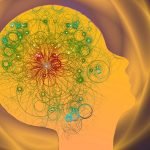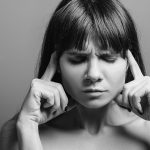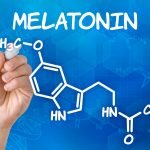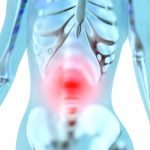Extra-GI Manifestations of Parasites and Their Link to Autoimmune Arthritides
Dr. Eugene R. Zampieron, ND MH(AHG) and Dr. Ellen Kamhi, PhD, RN
Parasites often can be a major factor underlying unexplained health problems, including allergies, fatigue, chronic intestinal dysbiosis and joint pain. This article explores how a parasitic infestation may be a causative factor in arthritis, leading to inflammation and deterioration of the joints. Outlined is how alternative medicine – through colon cleansing, herbs and dietary recommendations – can help eliminate parasites and alleviate arthritic problems.
What is a Parasite?
Parasites feed off of the host’s nutriture, usually to the host’s detriment.
Parasites may reside in the intestines, but many species migrate during certain life stages to the blood, lymph, heart, liver, gall bladder, pancreas, spleen, eyes and brain, as well as inside the lining of the joints.
More than 300 kinds of parasites can live in the human body. They generate numerous symptoms, including headaches, back pain, energy loss, “spaciness,” vomiting, weight loss, colitis, gas, uncontrolled appetite, acne, and joint and muscle pain. Conventional medicine rarely considers testing for parasites as a possible causative factor for these symptoms.
In the United States, the most common parasites, apart from head lice, are microscopic protozoan: Giardia lamblia, found in contaminated water, is a common cause of traveler’s diarrhea (Hlavsa 2005); Entamoeba histolytica can cause dysentery and injure the liver and lungs; Blastocystis hominus is increasingly linked to acute and chronic illnesses; Dientamoeba fragilis is associated with diarrhea, abdominal pain, anal itching and loose stools; and Cryptosporidia spp., which is particularly dangerous to those with compromised immune function. Arthropod parasites, which include mites, fleas and ticks, can carry smaller parasites that are also infectious to humans. Of particular interest to arthritis patients is Borrelia burgdorferi, a spirochete that causes Lyme disease, a condition with many arthritis-like symptoms. Larger parasites include pinworms, tapeworms, roundworms, hookworms, filaria (thread-like worms that inhabit the blood and tissues) and flukes (which invade the liver). Parasites can be difficult to diagnose and often evade detection, especially if they are in a life phase where they have escaped the alimentary tract and have invaded other organ systems.
The Link Between Parasites and Arthritis
Parasites cause joint pain in two ways: 1) by directly invading a joint; and 2) through the production of toxic waste products that increase the body burden of circulating immune complexes, which initiate an exaggerated immune response. The possibility of parasitic infestation should be considered in all cases of autoimmune arthritis.
Medical researchers around the world have reported on the correlation between parasites and arthritis. As research progresses, some species of parasites that were thought to be found only in other species have now been found to cause rheumatoid arthritis in humans.
Researchers in Austria found Toxocara canis, which usually infects dogs, foxes and cats, to be the causative agent of dozens of cases of RA (Auer and Aspock, 2004).
Brachiola algerae is a parasite that infects skeletal muscle in humans and is identical to the species isolated from mosquitoes and cultured in mice. It has been isolated from arthritis patients (Cali et al., 2004).
A report from Germany cites a case of a child with arthritis caused by intestinal cryptosporida. Symptoms were relieved with resolution of the cryptosporidia infection (Sing et al., 2003).
Rheumatologists at Children’s Hospital in Seattle have treated children with reactive arthritis and Reiter’s syndrome due to Cryptosporidum spp. infestation (Sherry et al., 1995).
Researchers at the Children’s Hospital of Eastern Ontario in Ottawa, Canada, stated that arthritis can result from infestation by Giardia lamblia. Two children with knee problems were misdiagnosed until Giardia cysts were isolated in their stools. The arthritis cleared upon successful treatment of the Giardiasis (Letts et al., 1998).
Parasitologists at the Department of Medical Research in Yangon, Myanmar, isolated Entamoeba histolytica from the knee of an arthritic patient, and felt strongly that it was related to the pathophysiology (Than-Saw et al., 1992). The diagnosis was almost missed because the physicians initially only cultured the synovial fluid, which was negative for bacteria, instead of staining and examining under microscopy, the correct procedure for detection of parasites.
Doctors in India describe a case of arthritis where larvae of Strongyloides stercoralis were isolated in the stool and duodenal of an arthritis patient whose symptoms were resolved after antihelminthic (anti-parasite) treatments (Ghotekar et al., 2003).
Further confirmation of Strongyloides stercoralis-induced arthritis was elucidated from a Korean Medical team at Inje Unversity, Seoul. They reported a strong correlation between infection and arthritis in nine patients. In one of these patients, 220 adult parasitic organisms were found in one stool sample (Lee et al., 1994).
In the U.S., Cyclospora cayetanensis has been linked to many food poisoning outbreaks, and also has been associated with a variety of long-term illnesses, such as Guillain-Barre syndrome and arthritis (Shields and Olson, 2003).
In Jamaica, physicians at the University of West Indies report on a woman with severe arthritis affecting the knees on prednisone therapy. Blastocystis hominus, normally a GI organism, was not only isolated in the stool, but had migrated through the gut wall into her joints and was isolated from her synovial fluid. The arthritis ceased after treatment with metronidazol (Lee et al., 1990).
Scottish researchers report that rheumatic syndromes occur in a variety of parasitic diseases, and that effective diagnosis of a parasitic origin is hampered by the confusion caused because afflicted patients may live far from the usual geographic area of a particular parasite, due to travel and immigration (McGill, 1995). In addition, these researchers have correlated a variety of musculoskeletal problems with different parasitic infestations.
“The diagnosis of parasitic rheumatism is supported by poor response to anti-inflammatory drugs and improvement following anti-parasitic treatment” (McGill, 2003).
Perhaps, an anti-parasitic mechanism of action explains the success of drugs like hydroxychloroquine, an important allopathic drug for autoimmune disease used originally for malaria, a parasitic organism.
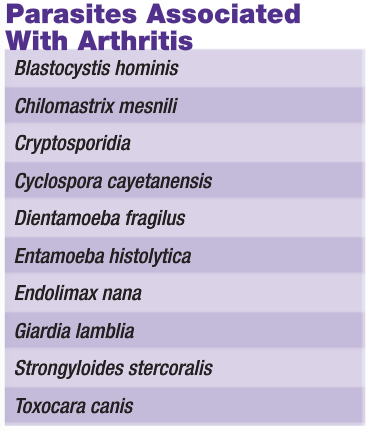
Diagnosing Parasite Infestations
If you suspect a patient may have parasites, make sure your testing facility follows the investigational guidelines set by the U.S. Centers for Disease Control in the Manual of Clinical Microbiology (Murray, 1999). In general, parasites can be very difficult to positively diagnose. Conventional physicians often will order a simple stool analysis. If the results are negative, parasites are ruled out. However, in many cases, the parasites are present but have avoided detection.
Several methods of testing can be used to diagnose parasites (Cancrini and Iori, 2004):
- Macro/microscopic analysis of tissue samples – Always recommended. This includes microscopic analysis of synovial tissue in addition to microbiological culture. This “old” procedure allows for immediate identification of all parasites present in mixed infections, and evaluation of the parasite load. It is a cost-effective method that relies ultimately on the skill of the observer to detect and identify parasite stages.
- Parasite antigen detection – Useful to directly diagnose “occult” or hidden infections.
- Parasite DNA/RNA – Sensitive and specific procedure, which can also identify sibling species.
- Host antibody detection – Indirect tool to detect the presence of parasites by evaluating the host’s response to infection.
Natural Parasite Elimination Techniques
A period of general body detoxification is necessary prior to starting a parasite removal program. Detoxification enables the body to handle destruction of the parasites and liberation of toxic substances which, if absorbed by the body, can lead to a die-off (Herxheimer) reaction. Typically, die-off symptoms may include malaise, fever, coated tongue and gastrointestinal disturbances.
The Herxheimer reaction can also cause a flare-up of preexisting conditions, including joint pain, headaches, bloating, itching and mood swings. Bear in mind that these are, in fact, good signs, indicating the power of the Vis Medicatrix Naturae.
Parasites can be difficult to eradicate. As the adult forms are killed, they often form and deposit spores or eggs in body tissues, which hatch after two to three weeks. Therefore, the parasite cleansing program needs to be in effect for at minimum several life cycles of the organism.
After finishing a parasite cleanse, the diagnostic tests should be repeated every two months until the tests are clearly negative three times. In addition, pay attention to any increase in previous symptoms. Although self-treatment is possible, we advise that all patients have a knowledgeable health-care practitioner follow their progress; be sure this practitioner is familiar with parasite life cycles, testing and cleansing procedures.
Herbs for Parasites
Herbs have been used for thousands of years in cultures around the world for their anti-parasite activity. In many instances, they are more effective and safer than prescription drugs. Purgative herbs, such as pumpkin seeds, act as mild intestinal cleansers. Decoctions and powders of pumpkin seeds contain cucurmoschin, which has been studied for its anti-fungal activities (Wang and Ng, 2003). Pumpkin seeds help to destroy tapeworm and other intestinal parasites. Here is a list of some herbs and their usage:
- Garlic (Allium sativum) – One of the least expensive yet most effective ways to treat many parasites. Raw garlic and garlic extract have been shown to destroy common intestinal parasites, including roundworms, hookworms, yeasts and other fungi forms. The mechanism of action of the active constituents of garlic has been investigated. It is interesting to note that garlic destroys pathogenic cells, but does not harm the cells of the body. The small molecules of the active constituents in garlic are able to cross cell membranes and combine with sulfur-containing molecular groups in the parasites, and interfere with their metabolic processes. The healthy cells of the body that contain glutathione offset the destructive effects of the allicin and other active anti-microbial constituents of garlic. In addition, garlic activates the normal activity of the immune system (Davis, 2005). Garlic has been shown to be specifically effective against many parasites (Anthony et al., 2005).
- Goldenseal (Hydrastis canadensis), Mahonia aquifolium and Berberis vulgaris – Berberine is an alkaloid compound found in particularly high concentrations in the roots. Berberine inhibits the growth of several common parasites that invade the intestine, vagina and oral cavity, including Entamoeba histolytica, Giardia lamblia, Erwinia carotovora and Leishmania donovania (Hwang et al., 2003).
In one study, children with giardiasis were given either berberine sulfate (a standardized extract) or the drug Flagyl. After 10 days, both substances produced similar results: 90% of the berberine-treated group no longer had Giardia in their stools, compared to 95% of the Flagyl-treated group. Unlike the Flagyl-treated group, however, those receiving berberine suffered no negative side effects (Gupte, 1975).
- Thyme (Thymus vulgaris) – The principle chemical components found in thyme are the volatile oils phenol, thymol and carvacrol (Azaz et al., 2004). Thymol is one of the most potent antimicrobial substances known, and even surpasses many of the strongest antibiotics. Thymol’s antimicrobial activity is 18 times more powerful than phenol, the major antiseptic used in commercial germicidal cleansers like Lysol, and can destroy parasites, worms, fungi, bacteria and many viruses (Kalemba and Kunicka, 2003). The recommended dosage is five drops of thyme essential oil diluted in a quart of pure water as an enema solution.
- Epazote/Semi-Contract (Chenopodium ambrosoides) – Epazote is also called worm seed or Mexican tea. It has been traditionally used in the Caribbean and Central America for worms, and has been scientifically studied for its effectiveness as an anti-parasite treatment (Giove Nakazawa, 1996). The active components are the volatile oils artemisin and santonin. The herb should only be used in crude drug form as an infusion and according to its ethnobotanical indications (i.e., short durations of no more than 10 days at a time for periodic antiparasitic cleansing); the purified oil can cause death, aphasia and brain damage if used incorrectly!
Among the Native Americans in Mexico and the Maroon people of Jamaica, Chenopodium is used for short periods as a tea in the spring: A mild tea is prepared for children and a stronger one for adults, as a preventive measure against parasites. If parasites are already a problem, a very thick brew of the plant is prepared and taken by the spoonful. Make an infusion by steeping 3-4 teaspoons of the dried or fresh herb in one cup of water for 20 minutes; drink one cup per day.
- Wormwoods (Artemesia absinthium;Artemesia santonica) – Many species of Artemesia have long histories as vermifuges or “worm expellers.” It was prized by Hippocrates (460-377 b.c.) for its ability to expel worms because of its thujone/thujyl content; it may be toxic if used alone in large quantities. It is usually mixed in formulas with citrus seed extract and other anti-parasitic herbs, such as black walnut hulls (Juglans nigra) and ground cloves (Eugenia spp.).
- Ayurvedic Botanicals – The traditional Indian medical science of Ayurveda has several natural remedies that address specific parasite infections. Modern trials support using Mormordica charantia, a cucumber-shaped fruit best used cut up and eaten in small pieces with other vegetables because of its bitter taste. Consuming one or two bitter melons a day for seven to 10 days, then repeating this after one month, can be effective in the treatment of pinworms. If pinworms are present, small white worms will be present in the stool the day after eating bitter melon. The active constituent, momordicins, may be responsible for bitter melon’s anti-worm effects (Beloin et al., 2005). Small protozoan parasites, such as Giardia, amoebas and Cryptosporidium, require a longer course. The herbs most effective for these microscopic intruders are bilva, neem (Azadirachta indica) and berberine, which can be taken in combination. Also, extracts of Piper longum with Butea monosperma (Palash) have been reviewed in the literature to be successful in Giardiasis, not via direct killing of the parasite, but via enhancing host recruitment of the leukocytes (Management of giardiasis by a herbal drug ‘Pippali Rasayana’: a clinical study. J Ethnopharmacol).
Dietary Changes
Parasites are often passed along through the consumption of raw foods, especially animal products such as sushi. Soak all vegetables, including those organically grown, in salted water (one tablespoon salt for five cups of water) for at least 30 minutes before cooking to kill parasites and their eggs. Raw goat milk is excepted because it contains IgA and IgG immunoglobulins, which help protect the intestinal lining from infectious agents.
Anti-parasitic foods include: Pineapple and papaya, either as fresh juice or in organic supplement form; Pomegranate juice; finely ground pumpkin seeds; and raw garlic. Certain foods inhibit parasite growth, such as garlic, onions, papaya, pineapple, pumpkin seeds, figs, pomegranate seeds and the seeds of the Rangoon creeper fruit (Quisqualis indicae). Since most commercial fruit is irradiated, the amount of enzymes found in fresh pineapple and papaya, unless organic, is minimal. The enzymes are needed to break down parasites inside the body. Digestive pancreatic enzymes as well as bromelain and papain should be taken as supplements both with and between meals. When taken with meals, they aid digestion; when taken between meals, they help break down the cell walls and cysts of the parasites. Pomegranate seeds juice can traditionally aid in the expulsion of worms, although no clinical research to date supports this folkloric usage.
How to Avoid Parasites
Several precautions will help patients avoid parasites:
Food
- Do not eat raw beef or pork – it can be loaded with tapeworms and other parasites.
- Do not eat raw fish or sushi – anyone is almost certain to get worms if they eat raw fish.
- Wash hands after handling raw meat or fish (including shrimp) – no one should put their hands near their mouth without washing them first.
- Use separate cutting boards for meat and vegetables – spores from meat can seep into the board and contaminate vegetables or anything else put on the board.
- Wash utensils thoroughly after cutting meat.
- Wash vegetables and fruit thoroughly – particularly salad items, as they often harbor parasites. Wash in one teaspoon Clorox per gallon of water. Soak for 15-20 minutes. Then soak in fresh water for 20 minutes before refrigerating. Or, substitute a few drops of grapefruit seed extract.
- Do not drink from streams and rivers.
Pets
- Do not sleep near pets – they harbor many worms and other parasites.
- De-worm pets regularly and keep their sleeping areas clean.
- Do not let pets lick faces.
- Do not let pets eat off dishes.
- Do not walk barefoot around animals.
General
- Always wash hands after using the toilet.
- Wash hands after working in the garden – the soil can be contaminated with spores and parasites.
When Traveling
- Don’t drink the local water. Buy filtered water.
- Start taking herbs or other preventive medications two weeks before traveling, and continue them during travel.
References
Hlavsa MC. Morbidity and mortality weekly report, United States Center for Disease Control, Surveillance Summary, Jan 28, 54(1):9-16, 2005.
Auer H, Aspock H. Nosology and epidemiology of human toxocarosis – the recent situation in Austria, Wiener Klinische Wochenschrift 116 Suppl 4:7-18, 2004.
Cali A et al. An analysis of the microsporidian genus Brachiola, with comparisons of human and insect isolates of Brachiola algerae, Journal of Eukaryotic Microbiology Nov-Dec 51(6):678-85, 2004.
Sing A et al. Reactive arthritis associated with prolonged cryptosporidial infection, Journal of Infection Aug 47(2):181-4, 2003.
R.Q. Sherry et al. Reiter’s Syndrome associated with cryptosporidial gastroenteritis, Journal of Rheumatology 22:1(Oct), 1962-1963, 1995.
- Letts et al. Synovitis secondary to giardiasis in children, American Journal of Orthopedics 27:6 (June), 451-454, 1998.
Than-Saw et al. Isolation of entamoeba histolytica from arthritic knee joint, Tropical and Geographical Medicine 44:4 (Oct), 355-358, 1992.
Ghotekar LH et al. Reactive arthritis, psoriasiform lesions and protein loosing enteropathy secondary to Strongyloidiasis, Journal of the Association of Physicians of India Apr 51:395-6, 2003.
Lee SK et al. Nine cases of strongyloidiasis in Korea, Korean Journal of Parasitology 32:1 (Mar), 49-52, 1994.
Shields JM, Olson BH. Cyclospora cayetanensis: a review of an emerging parasitic coccidian. International Journal for Parasitology Apr 33(4):371-91, 2003.
Lee MG et al. Infective arthritis due to Blastocystis hominis, Ann Rheum Dis. Mar 49(3):192-3, 1990.
McGill PE. Rheumatic syndromes associated with parasites, Baillieres Clinical Rheumatology 9:1 (Feb), 201-13, 1995.
McGill PE. Geographically specific infections and arthritis, including rheumatic syndromes associated with certain fungi and parasites, Brucella species and Mycobacterium leprae. Best Practice & Research, Clinical Rheumatology Apr 17(2):289-307, 2003.
Murray PR (ed). Manual of Clinical Microbiology, Washington, DC, 1999, ASM Press.
Cancrini G, Iori A. Traditional and innovative diagnostic tools: when and why they should be applied. Parassitologia Jun 46(1-2):173-6, 2004.
Wang HX, Ng TB. Isolation of cucurmoschin, a novel antifungal peptide abundant in arginine, glutamate and glycine residues from black pumpkin seeds, Peptides Jul 24(7):969-72, 2003.
Davis SR. An overview of the antifungal properties of allicin and its breakdown products – the possibility of a safe and effective antifungal prophylactic, Mycoses Mar 48(2):95-100, 2005.
Anthony JP et al. Plant active components – a resource for ant-parasitic agents? Trends Parasitol. Oct 21(10):462-8, 2005.
Hwang BY et al. Antimicrobial constituents from goldenseal (the Rhizomes of Hydrastis canadensis) against selected oral pathogens, Planta Medica Jul 69(7):623-7, 2003.
Gupte S. Use of berberine in the treatment of giardiasis, American Journal of Diseases of Children 129:866, 1975.
Azaz AD et al. Composition and the in vitro antimicrobial activities of the essential oils of some Thymus species, Zeitschrift fur Naturforschung C, Journal of Biosciences Jan-Feb 59(1-2):75-80, 2004.
Kalemba D, Kunicka A. Antibacterial and antifungal properties of essential oils, Current Medicinal Chemistry May 10(10):813-29, 2003.
Giove Nakazawa RA. Traditional medicine in the treatment of enteroparasitosis, Revista de Gastroenterologia del Peru Sep-Dec 16(3):197-202, 1996.
Beloin N et al. Ethnomedicinal uses of momordica charantia (vucurbitaceae) in Togo and relation to its phytochemistry and biological activity, Journal of Ethnopharmacology. Jan 4 96(1-2):49-55, 2005.
Management of giardiasis by a herbal drug ‘Pippali Rasayana’: a clinical study. J Ethnopharmacol.
Dr. Eugene R. Zampieron is a licensed naturopathic physician and alumni of Bastyr University. ‘Dr. Z’ is a medical herbalist and professional member of the American Herbalist Guild. Dr. Z was on the elite founding board that established the University of Bridgeport College of Naturopathic Medicine, and is now the most senior lecturer at the institution. He is a botanical formulations inventor, radio host and lecturer who teaches with an encyclopedic knowledge of natural medicine. Along with business partner Dr. Ellen Kamhi, he has co-authored hundreds of articles, as well as several books. He practices in Woodbury, CT and is an ethnobotanist with www.EcoToursforCures.com, leading adventure and ecologically based tours and specialty travel groups into the rainforests around the globe. His Web site is www.DrZnaturally.com.
The Natural NurseTM, Dr. Ellen Kamhi attended Rutgers and Cornell Universities, and is nationally board certified as a holistic nurse (HNC). She sat on the Panel of Traditional Medicine at Columbia Presyterian Medical School, and is clinical instructor at SUNY Stony Brook Medical School. A multimedia celebrity, she has co-authored The Natural Medicine Chest and Arthritis, The Alternative Medicine Definitive Guide and Cycles of Life. She is a nationally known professional speaker and currently works in the natural products industry. Her Web site is www.NaturalNurse.com.




